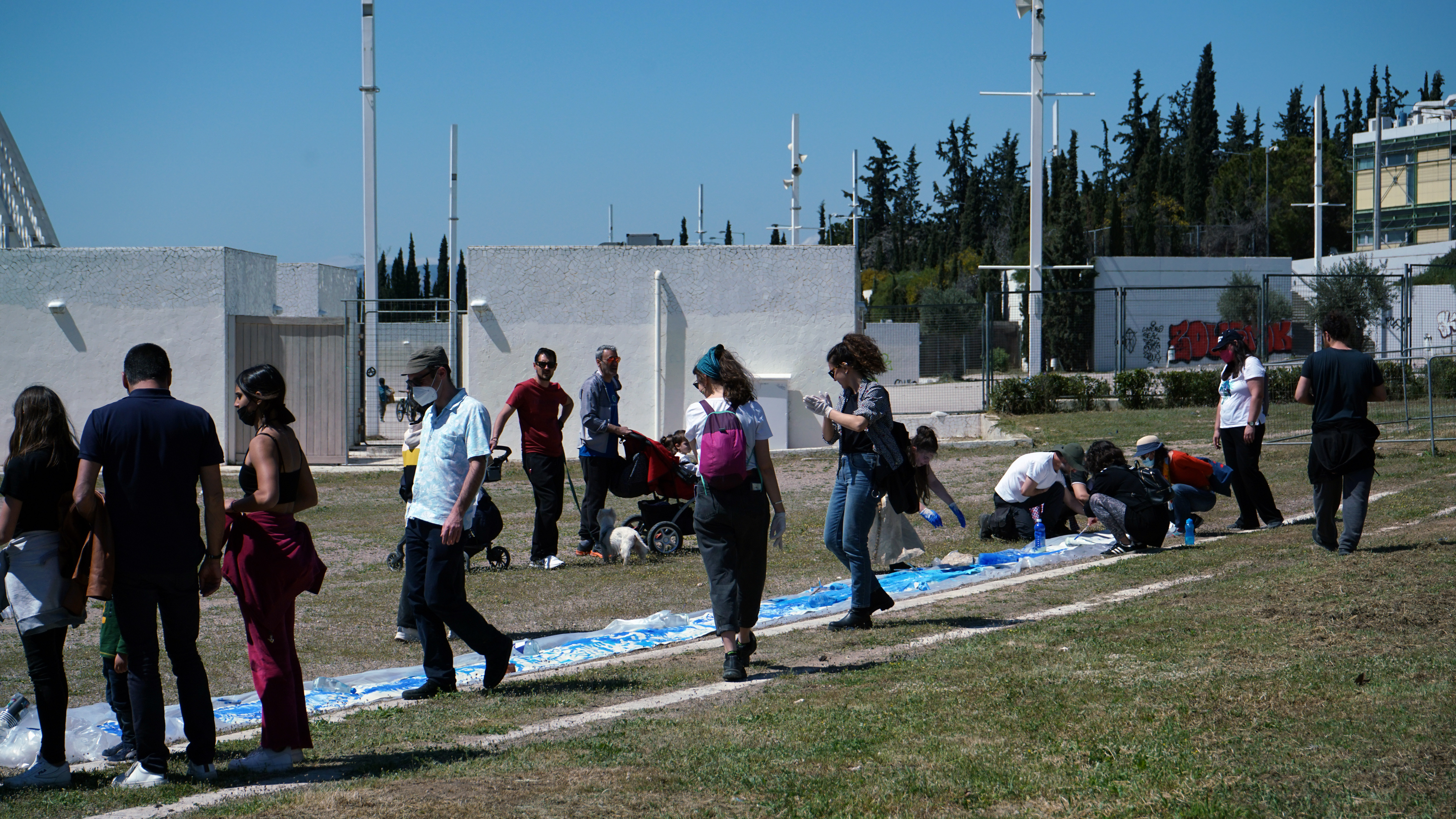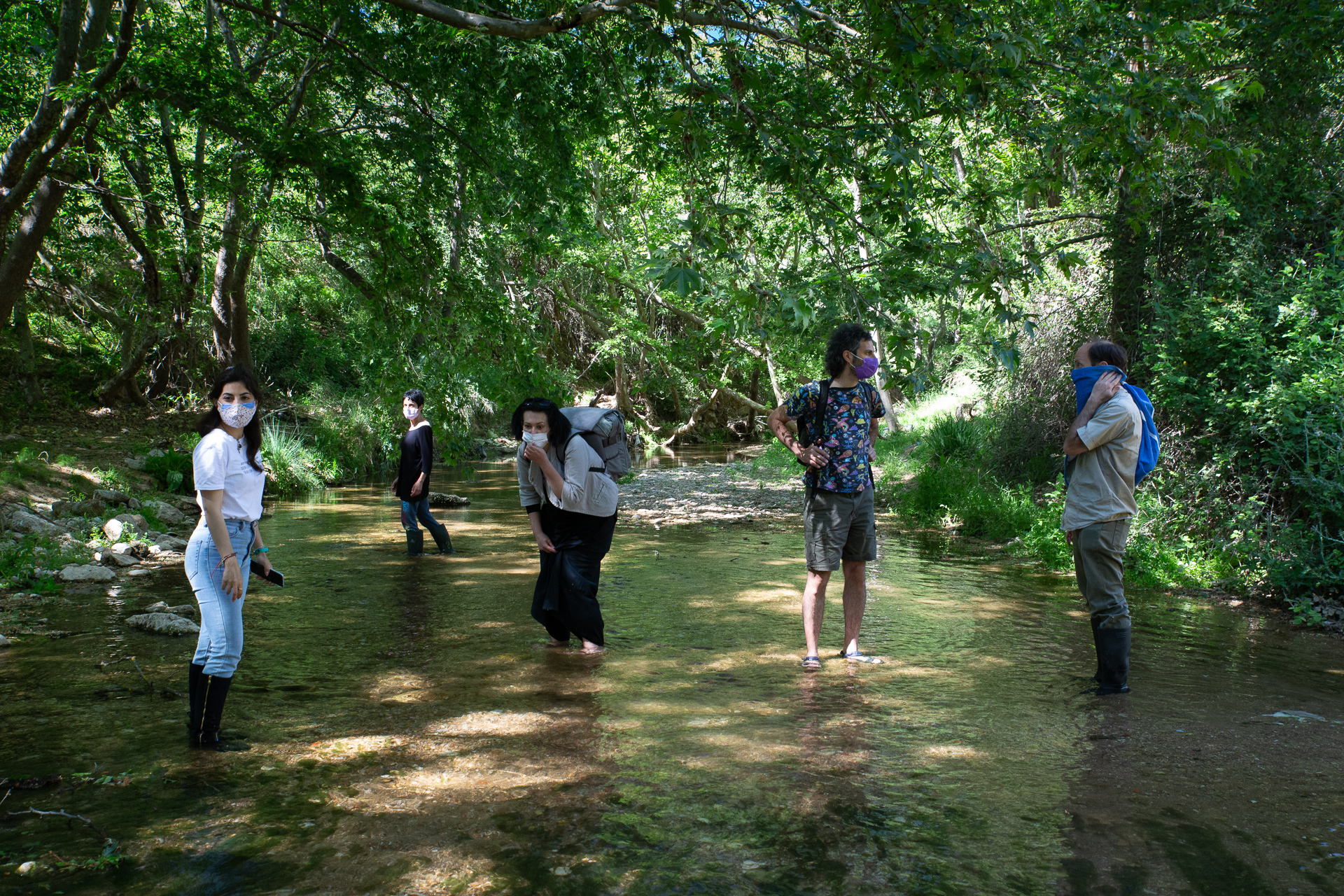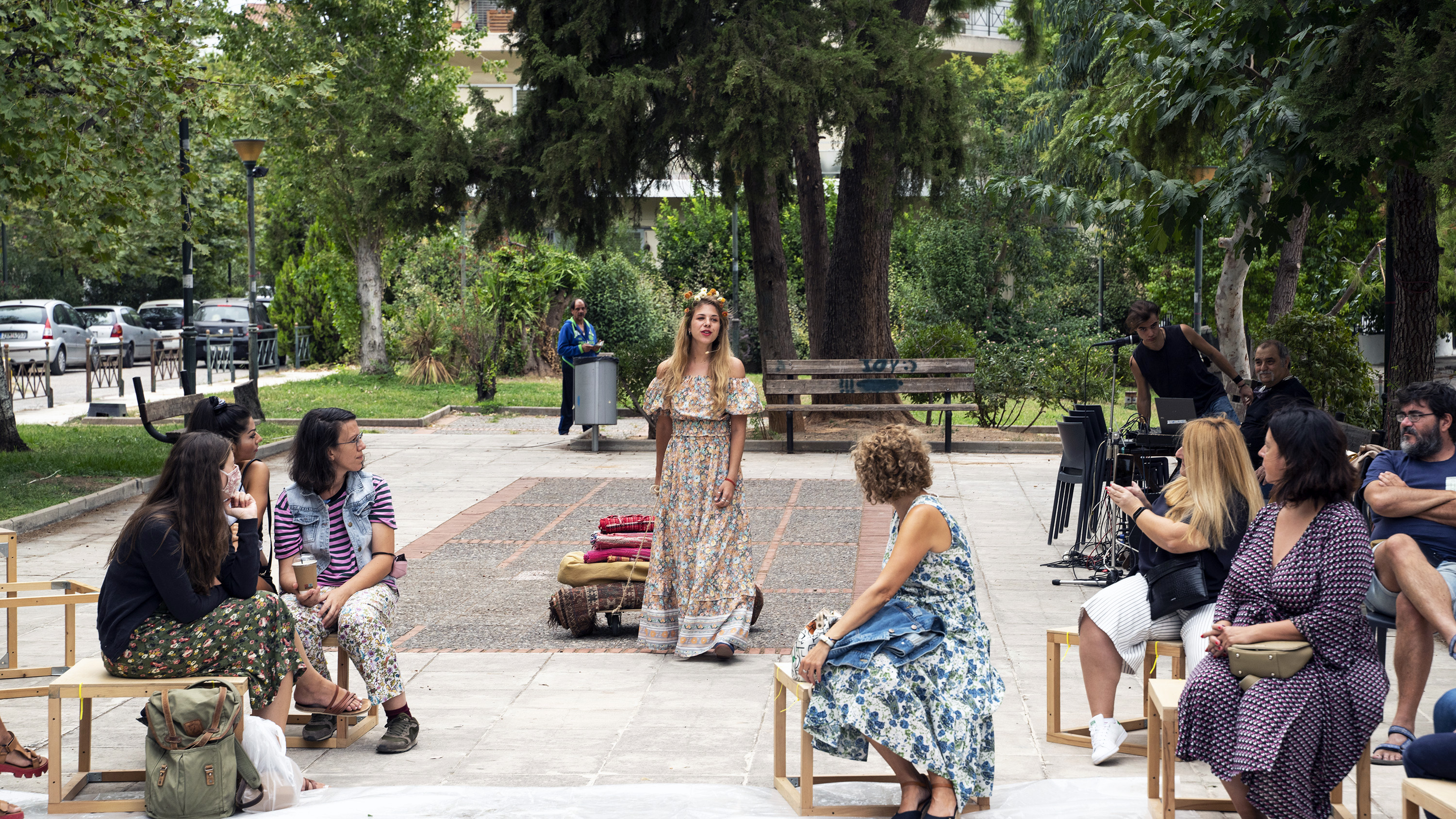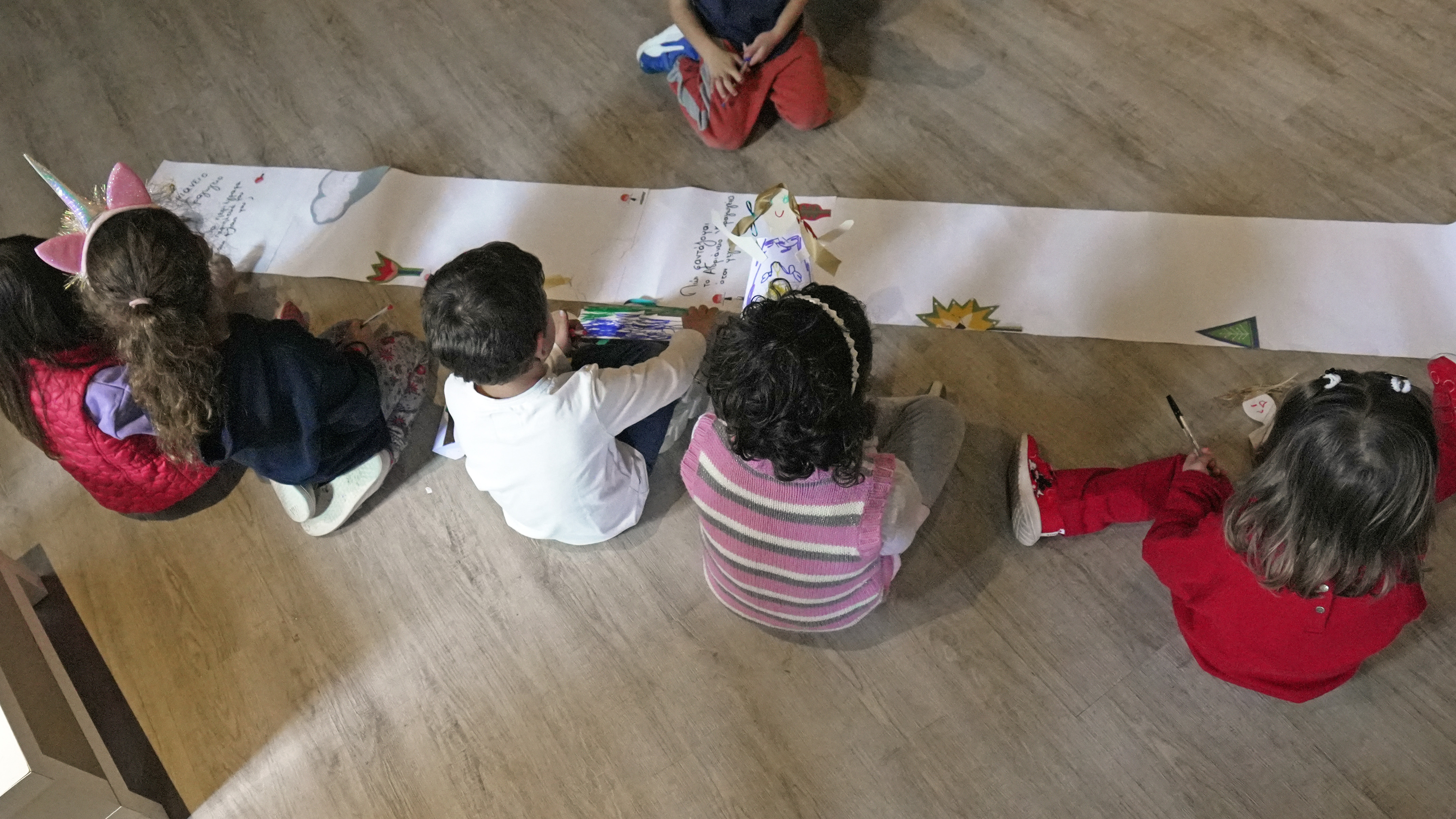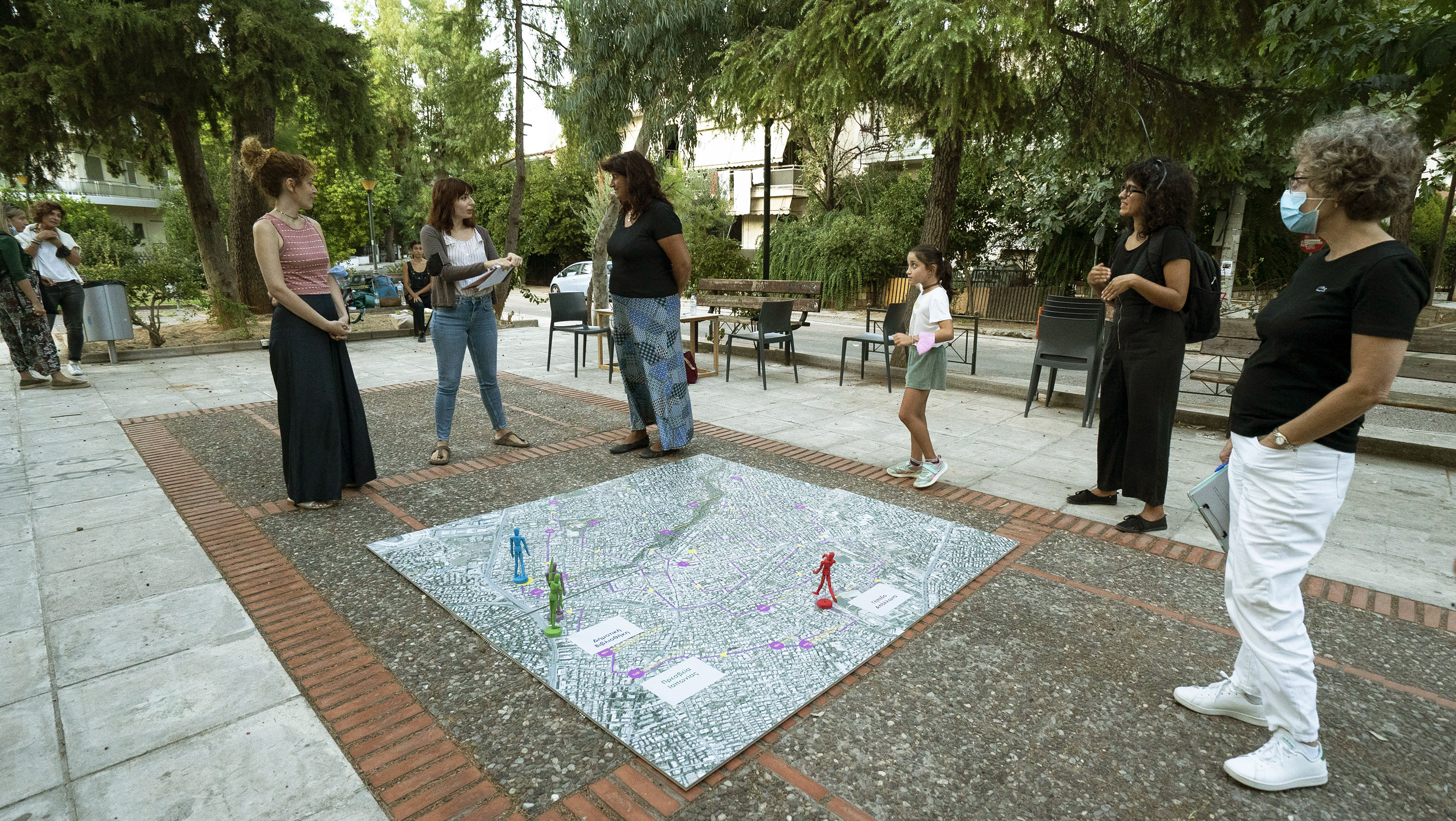Reconnecting with nature
Walkers on Water (WoW)
Walkers on Water. Methodology of translocal cooperation towards urban development driven by citizens
Have you ever thought of water as a walk, a source of culture, a meeting ground? The Walkers of Water invite you to The Hadrian's Aqueduct and join a process of imaginative, structured, artistic, participatory activities aiming to reconnect citizens with nature both as participants and co-designers. UrbanDig "water-walks" the Hadrian Aqueduct, drawing inspiration from its triple status as an obscure cultural monument, an unused water vein, and an unseen underground route.
Greece
Regional
Attica Region
It addresses urban-rural linkages
It refers to other types of transformations (soft investment)
Yes
2022-03-05
Yes
Active Citizens Fund. The Active Citizens Fund program, with a total budget of €13.5 million, is funded by Iceland, Liechtenstein, and Norway and is part of the European Economic Area (EEA) Financial Mechanism for the 2014–2021 period, known as EEA Grants.
No
No
As a representative of an organisation
Since the beginning of their journey, Walkers on Water (WoW) have been attempting to "walk" and reduce the distance that often exists between citizens and civil society actors and residents on the one hand, and decision-makers regarding urban development on the other. WoW have sought to bridge the gap between people and nature, addressing the disconnect between them in shaping the future of urban natural resources. By focusing on water as both an ecological and cultural asset, the project aimed to redefine participation in urban development, particularly in relation to hidden yet vital groundwaters of the Hadrian Aqueduct of Athens. WoW revived public awareness and connection with a forgotten yet active historical water system. Drawing elements from artistic and cultural practices, the project focused on the participatory design of activities aiming to highlight and inspire the good use of a unique cultural and water resource that passes under our feet: the Hadrian Aqueduct that still carries water! It is over 20 km long, underground and connects the municipalities of Acharnes, Metamorfosis, Kifissia, Heraklion, Chalandri, Maroussi, Filothei-Psychiko and Athens. It is an urban resource of unique value in terms of environment (water), culture (monument) and urban networking (network).Within a course of 22 months, numerous internal meetings, 24 open activities and the “Little Hadrian Festival” and with the company of more than 300 participants and the water community of "Hadrian Lovers", WoW tested their goals in real conditions and ended up with an original Methodology of participation and nature oriented community development. WoW also played a significant role in the creation of a one-of-a-kind active community in Chalandri that today is already in charge of the water distribution from the Aqueduct. WoW’s methodology is also part of an MoU between our entity and the Region of Attica in order to be used in view of Integrated Spatial Investment for the Aqueduct.
Public participation
Recreational processes
Artistic innovation
Urban Futurism
Experiential engagement with nature
The WoW project was designed as an innovative participatory experiment and was mainly focused on the Hadrian Aqueduct, a 20 km-long underground Roman water infrastructure that still carries water today. By engaging communities in rediscovering this overlooked asset, the project highlighted its potential for sustainable water management, urban resilience, and ecological awareness. Recognizing the barriers to civic participation, WoW introduced an experimental, trans-local methodology that brought together stakeholders. The project implemented structured dialogues, creative engagement tools, and community-driven decision-making processes, ensuring sustainability was approached as a collective, long-term commitment. Sustainability is not just a technical issue but a cultural and social one. The project designed gamified tools, dramatized presentations, guided tours, and a festival to engage diverse audiences, making the topic of water sustainability accessible, experiential, and inspiring. These creative formats ensured knowledge transfer and long-term impact beyond conventional awareness campaigns. Chalandri’s community as-we-speak advocates for the protection, responsible use, and the regeneration of the Aqueduct as a municipal natural resource.
WoW serves as a replicable model for integrating ecological assets into contemporary urban life transforming them into catalysts for sustainability through interdisciplinary and participatory approaches.
WoW serves as a replicable model for integrating ecological assets into contemporary urban life transforming them into catalysts for sustainability through interdisciplinary and participatory approaches.
The WoW project was designed as a multi-layered experience where art, cultural heritage, and participatory design converged to transform an unseen urban infrastructure into a source of inspiration, engagement, and collective reimagination. Although the Hadrian Aqueduct remains underground, the project used artistic and cultural tools to bring it to the surface—both metaphorically and experientially. Through dramatized presentations, interactive storytelling, and guided walks, participants engaged with the aqueduct not as a distant relic but as a living, breathing part of their urban environment. The project crafted a diverse range of activities that appealed to different senses and learning styles, ensuring accessibility and engagement for all. Gamified tools transformed historical and environmental knowledge into interactive exploration, while the festival and workshops infused the experience with creativity and collective expression. The project integrated art, performance, and public space interventions to reimagine the aqueduct’s role in the city. Public events became a stage for creative dialogues, while participatory methodologies invited citizens to co-design possible futures for this hidden infrastructure, emphasizing aesthetics alongside functionality. By weaving together historical heritage, artistic interpretation, and contemporary civic engagement, the project fostered a deeper meaningful connection with nature. The Hadrian Lovers community reflects the emotional and cultural connection participants developed with this rediscovered resource. WoW demonstrates how an invisible infrastructure can be reintroduced into public consciousness through aesthetic and experiential means. The project embraced play, performance, and participatory art to redefine cultural engagement with an urban eco-monument into a place of collective imagination.
The WοW project was designed with a main focus of breaking down barriers between citizens, civil society actors, and policymakers to co-create a shared urban future. The project prioritized accessibility, affordability, and democratic engagement, ensuring that all voices and ages, especially those traditionally excluded from urban decision-making,were heard. The project tackled the challenge of public participation by inviting diverse stakeholder, residents, cultural actors, environmentalists, and policymakers from multiple municipalities to engage in a structured yet open-ended dialogue. This trans-local approach fostered cross-community collaboration and ensured that participation was not limited to specific socio-economic groups or geographic areas.All activities were free of charge, removing economic barriers. The project leveraged interactive mapping, online discussions, artistic, gamified and digital engagement strategies and non-formal educational tools to reach broader audiences. Events took place in public spaces, making them easily accessible to people of all ages, backgrounds, and abilities. Online and in-person formats allowed flexibility, ensuring inclusivity for those unable to attend physical events, recognizing that different people engage in different ways, providing multiple entry points. Diversity of methods made the project engaging and accessible to individuals across generations, literacy levels, and cultural backgrounds. Beyond one-off events, the project established the Hadrian Lovers community and the water community in Chalandri, both grassroots networks that continue to advocate for the sustainable management of the Aqueduct. These self-organized groups embody a new societal model, where communities take ownership of their shared urban and ecological resources. WoW’s holistic approach, merging accessibility, participatory governance, and community empowerment, makes it a working example of how inclusive practices can reform everyday life.
The WoW project actively involved citizens and civil society in various participatory processes, fostering a deeper connection with the natural and cultural heritage of the Hadrian Aqueduct. Over 300 participants engaged in 24 open activities, including guided tours, dramatized presentations, workshops, and festivals, designed to encourage public awareness and involvement
A significant impact of this involvement was the formation of the "Hadrian Lovers" community, a core group of engaged citizens (10-15 people with an even broader network) and the important role of WoW methodology in forming the water community in Chalandri. Both still participate in structured discussions and creative activities that emphasized the importance of the aqueduct as an urban, cultural and environmental resource.
The project adopted a multilevel participatory approach, involving both citizens and decision-makers in co-creative processes.
This included:
Workshops with schools to raise awareness among younger generations.
Meetings with local authorities to explore how the aqueduct could be integrated into urban planning initiatives of the Region of Attica. The WoW methodology is alredy included to these initiaves.
Dramatized events and serious games, making environmental and cultural discussions more engaging and accessible.
The involvement of civil society extended beyond participation to methodological co-development, with citizens shaping discussions and decisions through interactive methodologies drawn from artistic and cultural practices.
Overall, the project successfully bridged the gap between communities and decision-making bodies, enhancing civic engagement and fostering a long-term sense of stewardship over water resources , urban commons. The WoW project actively involved residents, grassroots and civil society organizations, cultural actors, educators, and decision-makers, forming a collaborative and participatory approach to urban development.
A significant impact of this involvement was the formation of the "Hadrian Lovers" community, a core group of engaged citizens (10-15 people with an even broader network) and the important role of WoW methodology in forming the water community in Chalandri. Both still participate in structured discussions and creative activities that emphasized the importance of the aqueduct as an urban, cultural and environmental resource.
The project adopted a multilevel participatory approach, involving both citizens and decision-makers in co-creative processes.
This included:
Workshops with schools to raise awareness among younger generations.
Meetings with local authorities to explore how the aqueduct could be integrated into urban planning initiatives of the Region of Attica. The WoW methodology is alredy included to these initiaves.
Dramatized events and serious games, making environmental and cultural discussions more engaging and accessible.
The involvement of civil society extended beyond participation to methodological co-development, with citizens shaping discussions and decisions through interactive methodologies drawn from artistic and cultural practices.
Overall, the project successfully bridged the gap between communities and decision-making bodies, enhancing civic engagement and fostering a long-term sense of stewardship over water resources , urban commons. The WoW project actively involved residents, grassroots and civil society organizations, cultural actors, educators, and decision-makers, forming a collaborative and participatory approach to urban development.
WoW project successfully engaged stakeholders at multiple levels, local, regional, national, and European, ensuring a broad and impactful participatory process. The project fostered collaboration among municipalities, civil society organizations, cultural institutions, and policy actors, adding value through cross-sectoral knowledge exchange and capacity building.
1. Local Level: Citizens, Schools, and Municipalities
Engagement of Eight Municipalities (ongoing): The project connected citizens, communities and interdiscliplinary groups of people, across eight municipalities along the Hadrian Aqueduct (Acharnes, Metamorfosis, Kifissia, Heraklion, Chalandri, Maroussi, Filothei-Psychiko, and Athens), promoting trans-local dialogue.
Schools and Educational Institutions: Schools surrounding the aqueduct were engaged through live discussions and gamified workshops, fostering environmental awareness and youth participation.
Municipal Authorities: While direct engagement with local governments varied, some municipal representatives participated in workshops and structured dialogues. The implemented methodology and outcomes of WoW were also shared with various municipal athorities
2. Regional and National Level: Institutional and Policy Engagement
Collaboration with the Region of Attica: MoU with the New Metropolitan Attica Development Agency about the use of WoW’s methodology into future Integrated Spatial Investment (ISI) plans for the aqueduct.
Olympic Athletic Center of Athens (OAKA): A key partner in facilitating interactive guided tours, leveraging its location above the aqueduct.
3. European and Transnational Level: Knowledge Sharing and Methodology Development
Through our team's activities, which largely involve implementing projects related to water even beyond Greece, the multidimensional methodology of the WoW project has been presented to partners and members of the networks in which we participate (Water-Europe, Placemaking Week 2022).
1. Local Level: Citizens, Schools, and Municipalities
Engagement of Eight Municipalities (ongoing): The project connected citizens, communities and interdiscliplinary groups of people, across eight municipalities along the Hadrian Aqueduct (Acharnes, Metamorfosis, Kifissia, Heraklion, Chalandri, Maroussi, Filothei-Psychiko, and Athens), promoting trans-local dialogue.
Schools and Educational Institutions: Schools surrounding the aqueduct were engaged through live discussions and gamified workshops, fostering environmental awareness and youth participation.
Municipal Authorities: While direct engagement with local governments varied, some municipal representatives participated in workshops and structured dialogues. The implemented methodology and outcomes of WoW were also shared with various municipal athorities
2. Regional and National Level: Institutional and Policy Engagement
Collaboration with the Region of Attica: MoU with the New Metropolitan Attica Development Agency about the use of WoW’s methodology into future Integrated Spatial Investment (ISI) plans for the aqueduct.
Olympic Athletic Center of Athens (OAKA): A key partner in facilitating interactive guided tours, leveraging its location above the aqueduct.
3. European and Transnational Level: Knowledge Sharing and Methodology Development
Through our team's activities, which largely involve implementing projects related to water even beyond Greece, the multidimensional methodology of the WoW project has been presented to partners and members of the networks in which we participate (Water-Europe, Placemaking Week 2022).
WoW project was inherently multidisciplinary, integrating diverse fields to create an innovative, participatory model. It combined art, environmental sciences, cultural heritage, urban planning, participatory design, education, and digital tools, setting a new benchmark for sustainable, inclusive, and aesthetically engaging urban development. Interactive tools such as gamification and guided tours made participation accessible and engaging. Historians and urban planners worked with hydrologists to develop sustainable narratives around water use. Artists, performers and educators, played a central role in co-designing interactive learning experiences engaging the public through dramatized presentations, site-specific performances, and interactive storytelling that helped introduce youth to environmental and heritage issues. Environmental experts contributed insights into sustainable water use and conservation strategies. The festival was co-created with the participation of the Hadrian Lovers and local artists, offering a visioning and creative exploration of the urban landscape. The Aqueduct required engagement with archaeologists and cultural heritage professionals to interpret and showcase its significance. Municipal authorities and regional planners explored policy-driven urban revitalization strategies and pioneered a trans-local, citizen-driven methodology for participatory urban development. WoW successfully bridged the gap between civil society, educational institutions, academia, and decision-makers, setting bottom-up governance models with empowered citizens capable of (re)establishing strong connections between natural resources and everyday urban life.
WoW project stands out as a pioneering initiative in urban participation, cultural heritage engagement, and environmental sustainability providing a blueprint for the future of participatory urban development. Unlike mainstream top-down planning and passive historical preservation, the project introduced a bottom-up, participatory, and multidisciplinary approach that redefined how citizens interact with hidden urban infrastructures: from passive conservation to active co-creation. Heritage, environment, and civic participation are not separate fields, they can be integrated through artistic, inclusive, and community-driven methodologies that make cities more sustainable, beautiful, and socially connected. Most cultural heritage projects treat historical sites as non-interactive spaces. The project reimagined the Hadrian Aqueduct as a living system, not just a relic. It emphasized its contemporary relevance as a water resource and urban connector, engaging citizens in decision-making about its future. The project tested a new participatory methodology, using art, play, and storytelling to make urban planning inclusive, engaging, and accessible, allowing citizens to actively shape the discourse on urban transformation. Cultural heritage projects focus on history, while environmental projects focus on infrastructure, rarely intersecting. This project merged the arts, environmental sciences, digital tools, and governance models into an interactive and holistic framework. Traditional civic engagement methods often exclude broader public participation due to their complexity. The project used interactive performances, serious games, and dramatized dialogues to break down participation barriers. The aqueduct was personified as a speaking character, bringing water infrastructure into public consciousness in an unexpected and compelling way, engaging citizens of all ages and ensuring broader accessibility and emotional connection to the site.
WoW was developed around the Hadrian Aqueduct in Athens and was structured in three phases and six steps, ensuring progressive involvement of citizens, civil society actors, and decision-makers.
Phase A: Understanding Target Groups & Key Stakeholders
Mapping stakeholders & assessing readiness – Identifies key actors (residents, civil society, policymakers) through interviews, focus groups, and site visits. Introduction to the resource – Uses guided tours, dramatized presentations, and digital storytelling to create emotional and intellectual connections with the aqueduct.
Phase B: Expanding Engagement & Community Building
Deepening thematic exploration – Organizes interactive workshops and artistic interventions to sustain engagement.
Identifying and nurturing community members – Encourages committed participants to form a self-sustaining network (Hadrian Lovers).
Phase C: Empowering & Sustaining Participation
Capacity building – Provides tools for self-organization, decision-making, and advocacy through gamified learning and live-art performances.
Ensuring long-term community sustainability – Facilitates community-led initiatives and collaborations with municipalities to integrate the methodology into urban planning.
By blending art, play, history, and civic participation, the methodology transforms hidden infrastructures into living, interactive ecosystems. It is scalable and adaptable to various urban and environmental contexts, offering a replicable model for fostering local engagement with nature and cultural heritage.
Phase A: Understanding Target Groups & Key Stakeholders
Mapping stakeholders & assessing readiness – Identifies key actors (residents, civil society, policymakers) through interviews, focus groups, and site visits. Introduction to the resource – Uses guided tours, dramatized presentations, and digital storytelling to create emotional and intellectual connections with the aqueduct.
Phase B: Expanding Engagement & Community Building
Deepening thematic exploration – Organizes interactive workshops and artistic interventions to sustain engagement.
Identifying and nurturing community members – Encourages committed participants to form a self-sustaining network (Hadrian Lovers).
Phase C: Empowering & Sustaining Participation
Capacity building – Provides tools for self-organization, decision-making, and advocacy through gamified learning and live-art performances.
Ensuring long-term community sustainability – Facilitates community-led initiatives and collaborations with municipalities to integrate the methodology into urban planning.
By blending art, play, history, and civic participation, the methodology transforms hidden infrastructures into living, interactive ecosystems. It is scalable and adaptable to various urban and environmental contexts, offering a replicable model for fostering local engagement with nature and cultural heritage.
The project tested and refined a unique methodology for involving multiple stakeholders in urban decision-making so as to create a solid connection with nature. This methodology is now available for adaptation by other organizations, municipalities and initiatives working on participatory urbanism and civic engagement. It can be replicated and applied to other cultural heritage sites, public infrastructure projects, and environmental awareness campaigns. The establishment of the Hadrian Lovers community demonstrates how grassroots networks can be built around urban and cultural assets. This model can inspire similar community-driven initiatives in different urban and rural contexts. The methodology can serve as a preparatory tool for improving public participation in urban planning. Cities can adopt similar models to engage citizens in discussions about infrastructure, sustainability, and cultural heritage. NGOs and grassroots movements can use the project’s approach to enhance local engagement in civic and environmental issues. The community-building methods developed in Walkers on Water can strengthen collective ownership over shared spaces and resources. The participatory educational tools can be adopted by schools, museums, and cultural organizations to engage diverse audiences. The project demonstrated how participation can work at a trans-local level, offering a model that can be applied to multi-city collaborations.The interactive and artistic methodologies make urban participation accessible and engaging, encouraging sustained community involvement beyond the project's lifespan. Given the challenges of citizen participation in urban planning, WoW provides a proven, innovative methodology that cities across Europe can implement.
WoW project aligns with the New European Bauhaus vision by offering local, community-driven solutions to pressing global challenges. Through its innovative, participatory approach, the project tackles issues related to climate change, water sustainability, cultural heritage loss, urban disconnection, and civic participation deficits. By addressing water sustainability, cultural heritage revitalization, urban resilience, and participatory governance, WoW provides a local solution with global relevance. Its approach, grounded in sustainability, inclusivity, and urban aesthetics, demonstrates how cities worldwide can reconnect with their hidden, natural resources, and communities to build a more livable, resilient future and emphasized the potential reuse of underground water in modern cities, creating awareness around alternative water solutions. By engaging artists, performers, and historians, it redefined historical preservation, moving beyond static conservation toward interactive storytelling, dramatized performances, and participatory history-making ensuring that citizens, regardless of background, could take an active role in shaping their urban environment. The Hadrian Lovers community demonstrated how grassroots initiatives can reclaim forgotten spaces and advocate for sustainable urban transformation. The project pioneered a fusion of urban planning, environmental science, artistic performance, digital engagement, and participatory governance, showcasing how multidisciplinary approaches can create more holistic and sustainable solutions.
WoW project has significantly contributed to reconnecting with nature by fostering community engagement around the Hadrian Aqueduct, a unique underground water resource in Athens. Through participatory urban development, the project engaged over 300 direct participants and reached 5,350 indirect beneficiaries, strengthening their awareness of the environmental, cultural, and urban networking value of the aqueduct.
Key outcomes and impacts include:
Increased public awareness and participation, using artistic and cultural methods such as dramatized tours, storytelling, and interactive workshops.
Creation of the "Hadrian Lovers" community, a dedicated network promoting the sustainable appreciation and use of the aqueduct.
Engagement of local schools, introducing over 220 students and educators to environmental and water-related educational programs.
Development of a flexible and scalable methodology for participatory decision-making, tested across eight municipalities and shared with policymakers that is already being implemented in Chalandri and the water community that was created there.
Strengthening collaboration between citizens, civil society organizations, and decision-makers, establishing a dialogue platform for sustainable water resource management.
Integration of urban water heritage into public consciousness, inspiring future conservation efforts and potential reuse of aqueduct water for local needs.
The project bridged historical heritage with contemporary environmental concerns, encouraging long-term civic participation in urban commons. Its success demonstrates how creative engagement strategies can foster a stronger human-nature connection and enhance sustainable urban development.
Key outcomes and impacts include:
Increased public awareness and participation, using artistic and cultural methods such as dramatized tours, storytelling, and interactive workshops.
Creation of the "Hadrian Lovers" community, a dedicated network promoting the sustainable appreciation and use of the aqueduct.
Engagement of local schools, introducing over 220 students and educators to environmental and water-related educational programs.
Development of a flexible and scalable methodology for participatory decision-making, tested across eight municipalities and shared with policymakers that is already being implemented in Chalandri and the water community that was created there.
Strengthening collaboration between citizens, civil society organizations, and decision-makers, establishing a dialogue platform for sustainable water resource management.
Integration of urban water heritage into public consciousness, inspiring future conservation efforts and potential reuse of aqueduct water for local needs.
The project bridged historical heritage with contemporary environmental concerns, encouraging long-term civic participation in urban commons. Its success demonstrates how creative engagement strategies can foster a stronger human-nature connection and enhance sustainable urban development.

